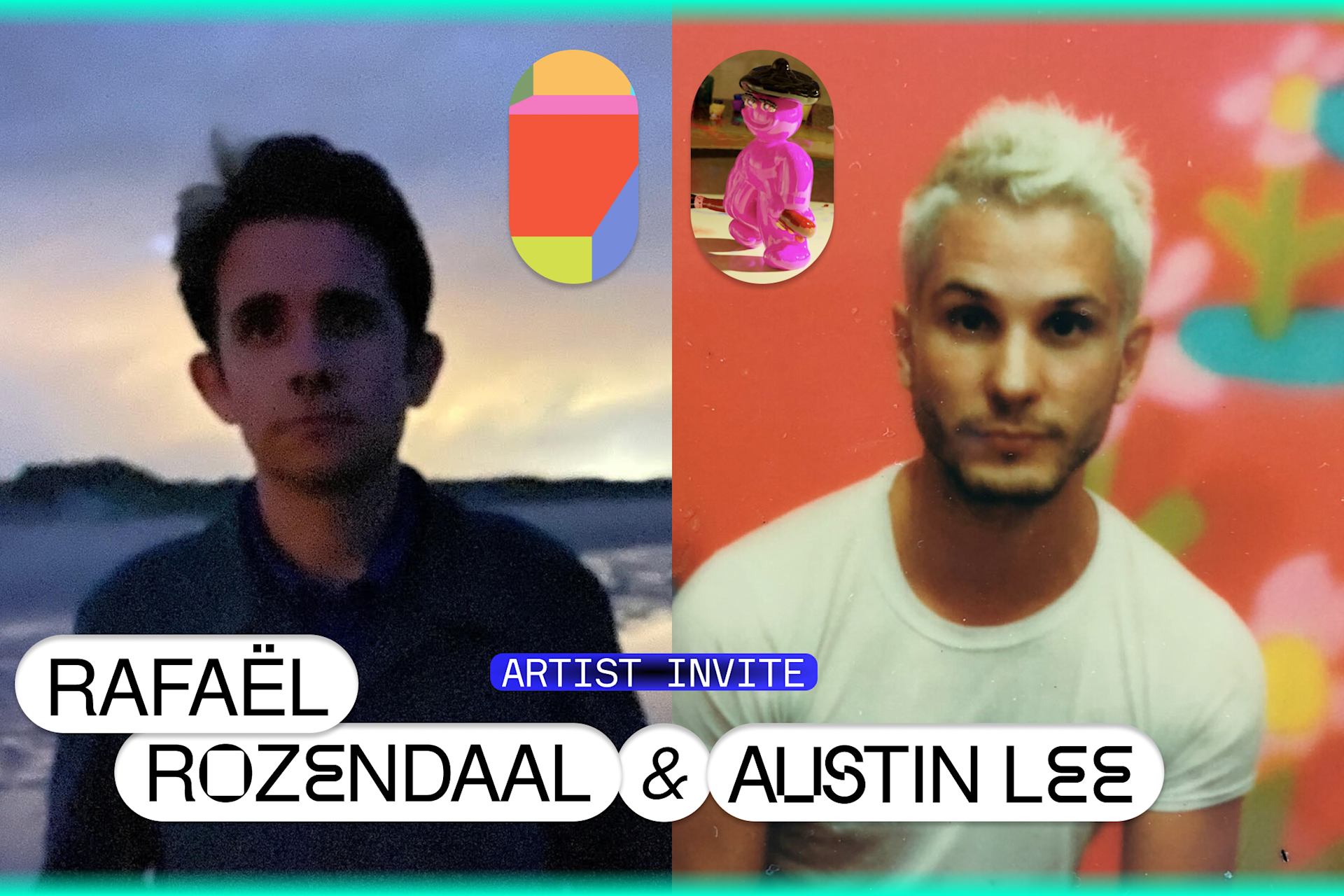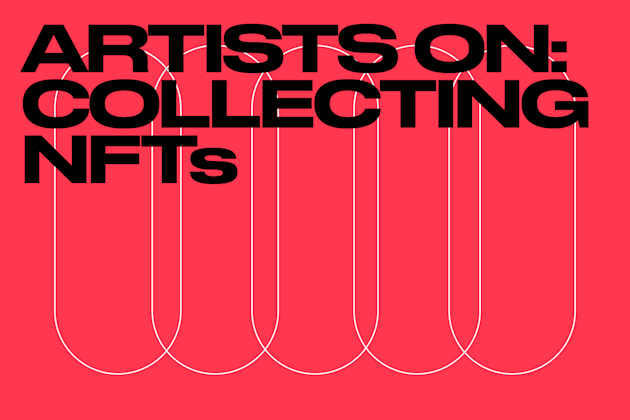Artist Invite: Rafaël Rozendaal & Austin Lee

Artist Invite is an ongoing series that connects the dots between creators on Foundation. Austin Lee was seated in the audience during one of Rafaël Rozendaal’s lectures at Yale University. After the talk, Austin introduced himself and invited Rafaël over for a studio visit. Rafaël was impressed by the way that Austin was able to translate his painting sensibilities from the screen to canvas—essentially making painting feel new again.
NFTs have brought forth challenges surrounding digital art-making processes for both artists. Austin Lee has been primarily invested in mediums like sculpture, painting, and installation until recently. Curious to see what he would create as an NFT, Rafäel invited him to join Foundation. For Artist Invite, the two interviewed each other about their creative strategies and approaches to digital art.
Rafaël Rozendaal: Do you think art should speak for itself? How do you feel about revealing your thoughts about your own work and process?
Austin Lee: Yes, I think art needs to speak for itself. Any additional information outside of the work can affect the understanding of the work, but it should not be reliant on it. The artwork itself should reveal something about the creator, but also about the viewer. Art is often more than the creator’s intentions—I think that’s what makes it interesting. I am happy to reveal my thoughts on the work and process, but I also don’t trust myself 100%. I don’t always know what something means. I understand some older works better now, than when I first made them. Just because I didn’t get it then, doesn’t mean it wasn’t there.
You are known for making physical works that feel digital. How do you feel now that you released animated works as NFTs?
Austin Lee: I have been surprised by how much the animated works have rounded out my process, because it feels like a way to communicate where the paintings and sculptures are coming from—something I thought was obvious, but wasn't. I definitely will continue to make them now, and it feels as natural as the rest of the work. I’m planning an upcoming museum show and I want to include some of the new animations.
How do you deal with distraction?
Austin Lee: If it’s a nice distraction then I embrace it. For me, art is about life, so you need experiences to make anything interesting. Taking time to read, or go see a show here and there actually makes the work better.
Do you ever run out of ideas? What do you do when you don’t know what to do?
Austin Lee: I usually find the idea through making the work, but I do have certain strategies that are more productive than others.
Drawing is how I start everything; just sitting and drawing helps things get started. I’ll sometimes just slowly draw leaves on a tree, or flowers. Some of it is just about looking and paying attention, slowing down, and focusing. Not necessarily work I’d do anything with, but it gets the mind wandering. Then the next drawing might be something.
Sometimes being bored is also the most productive. I’ll look for boring places to go to. I do lots of good sketching on airplanes, during lectures and doctor appointments, or at libraries. When I was in school, I would fill notebooks up with great drawings. If I need some sketches to work with, I’ll go to a diner, get a coffee, and draw for a while.
The next strategy I’ll try is to learn a new skill. I’ll watch YouTube tutorials on certain computer software techniques and then just figure out how to make art with it. Most of the NFTs I made came from that kind of experimenting. It’s like, “Oh Wow, I can make realistic water reflections!” And then I’ll make a drawing that has water in it. I focus on the water part, and then the rest is on autopilot. David Hockney and Caravaggio aren’t necessarily on my mind, but they are still in there somewhere, informing what I know about depictions of water. Everything you know is everything you know, so if you just do something simple, the rest comes along for the ride.
Austin Lee: You turned www.nosquito.biz and www.brokenself.com into real world adaptations for galleries in the past. I always thought these are beautiful translations of an idea. The user’s interaction seems to be the focal point in both, as opposed to the visuals. Do you think of them as performances?
Rafaël Rozendaal: I think most electronic works have a performative aspect to them. They don't have a final form, each device renders the work slightly differently. In the works you mentioned, I took that idea further, I considered the exhibition space the device, running the "software" in its own way. The software in this case is an instruction. I like the idea of making works that do not fit a single category. The work can morph to different spaces. An animated gif can become a billboard, or a website can become an opera. Ideally, if something is new, it does not follow previous rules. My favorite is when a work is so new that it seems ridiculous. I think something very new can be unintentionally comedic—art that is so simple or deadpan that it seems stupid. Somewhere between silly and profound.
Do you have a favorite work that you’ve made?
Rafaël Rozendaal: I don't pick favorites. I try to view my work as non-hierarchical. I like to follow artists and their many steps. Their entire body of work is the work, in which many small steps are made. Each separate work cannot be viewed without knowing the rest of the works. The concept of a favorite is a way of wanting control on something that naturally flows. It's a bit like standing under the shower and picking your favorite water drop, it's better to enjoy the shower experience as a whole.
One of the benefits of digital art is that you can see a lot of one artist’s work all in one place. Similar to music, you can browse the whole catalog. Physical art is usually spread out over many collections and therefore, you hardly ever see all the works together. Very few artists get a solo museum exhibition at the end of their life, but for internet art, it is possible.
You’ve been making works online for about twenty years, but in the grand scheme of things, internet art is still fairly young. Who are some artists you think have contributed since the beginning?
Rafaël Rozendaal: Jodi for stretching our idea of what a webpage can be, and Miltos Manetas for starting the idea of selling domain names as artworks.
Do you consider your work internet art, digital art, or new media art? Do you use any labels to help define it?
Rafaël Rozendaal: I’ve always pushed the idea of "internet art" because the internet has a DIY attitude. Even if an internet artist uses other mediums, the spirit is that of starting something without the permission of gatekeepers. Internet artists connect to their audience directly. They do not rely on the authority of institutions to legitimize their work.
As I grow older and the world changes, I do see the importance of curation. In a world of infinite content, viewers need some guidance. I think the internet art world and the traditional art world have been operating separately from each other. I am hopeful that these two worlds will come closer together. There is a lot to learn in both directions.
Read more

Why artists are collecting each other’s NFTs.

Reuben Wu is photographing the future.
